
* By the late 1960s, the Su-7 was obsolescent, but the Soviets regarded it as valuable enough to be worth improving. The result was the Su-17 / 20 / 22 variable-geometry strike fighters, which proved very successful and were widely exported.
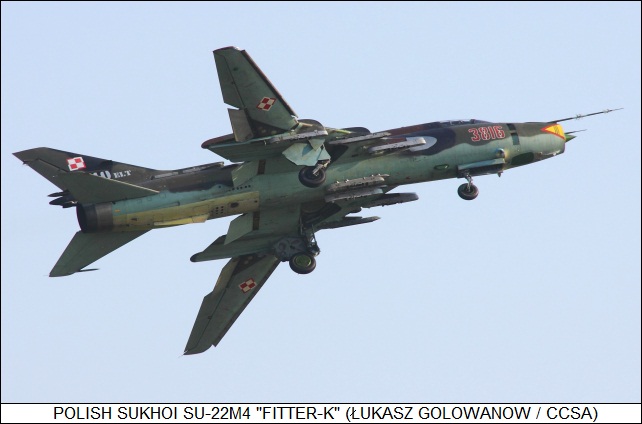
* In the early 1960s, the Soviets were very interested in developing combat aircraft with short-field capability. Long, prepared runways made good targets; in time of war, it would be preferable to disperse combat aircraft to small or rough airfields as protection against attack. The Su-7 was totally unsuited to short-field operation, and fixes such as RATO gear and dual brake parachutes didn't do much to improve matters. The hot landing speed of the Su-7 also was a clear liability, being the feature most disliked by its pilots.
Various prototypes of aircraft were built by the Mikoyan and Sukhoi OKBs to obtain improved short-field performance, with the effort following two main approaches: using "liftjets", small but powerful turbojets set vertically in an aircraft's fuselage to help get the aircraft into the air; and "variable geometry (VG)" or "swing wings", with the wing or part of the wing able to pivot in flight from a shallow sweep to a strong sweep.
The experience with the liftjet approach proved mixed; the VG approach ended up being much more successful. Following TsAGI recommendations, the Sukhoi OKB came up with a derivative of the Su-7 with VG outer wing panels just outboard of the main landing gear. This configuration meant the least alteration in Su-7 hardware, and also helped ensure flight trim -- swing wings tend to lead to fore-&-aft balance problems. A production Su-7BM was modified as a demonstrator, the "S-22I" -- with "I" standing for "izmenyayemaya (variable)".
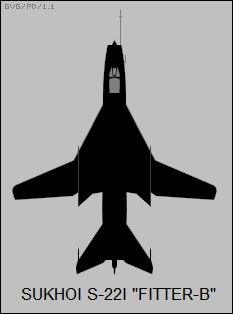
The demonstrator performed its initial flight on 2 August 1966, with well-known test pilot Vladimir S. Ilyushin at the controls. It was the very first flight of a Soviet VG jet. The machine went through its paces for the public at the Moscow-Domodedovo airport airshow on 9 July 1967, with the aircraft given a spiffy paintjob featuring blue lightning bolts. NATO assigned the type the reporting name "Fitter-B", with reports circulating long afterward that the aircraft had the designation "Su-7IG" -- though the machine was never assigned a service designation. Western observers concluded it was strictly a trials machine, on the belief that the Soviets would prefer a "clean sheet" design over recycling the obsolescent Su-7. That was underestimating the Soviet willingness to make the most of existing technology, as opposed to the American instinct of wanting to come up with the latest whizzy thing.
Trials of the S-22I were complete by the end of 1967. Take-off and landing handling was judged much superior to the Su-7, cutting the required airfield length in half. There was only a marginal improvement in range, and then only when the wings were left extended during main flight cruise. However, given that internal fuel tankage had been cut and empty weight increased -- mostly due to the heavy VG wing mechanism -- even staying in the same place as far as range went was a positive sign. In November 1967, the type was approved for production as the "Su-17", manufacture to take place once again at the Kosomolsk-na-Amure plant.
* Two pre-production Su-17s for evaluation were produced in 1969. This variant was basically an Su-7BKL with the VG wings and a number of tweaks, such as a dorsal spine like that of the Su-7U trainer, a clamshell canopy hinged in the rear instead of a sliding canopy, and a dual hydraulic drive system to support the VG wing pivot. The pivoting was manually controlled, initially with a two-setting switch: 30 degrees for take-off, landing, and loitering, and 63 degrees for high-speed flight. Later, a 45 degree setting was added for fast cruise. It took 19 seconds to fully extend the wings, 16 seconds to fully retract them.
The VG wing panels featured a leading-edge slat, while each fixed wing panel featured a single wing fence next to the VG wing panel; a second wing fence was added in the middle of the fixed wing panel in late production. Each VG wing section had ailerons and a slotted flap, with each fixed wing section featuring a two-section flap. There were two stores pylons under each wing -- a "wet" pylon directly under the wing fence, the other close to the fuselage. Along with the "traditional" belly pylons, that gave six stores pylons. The auxiliary wing pitot tube was relocated to the right side of the nose.
Avionics were generally updated, with a new radio, a new navigation system, SPO-3 Sirena-10 RWR, a RV-5 radar altimeter, and SAU-22 flight control system (FCS), which provided considerable automation of take-off, landing, and normal flight; it also worked in conjunction with a toss-bombing sight. An optical sighting system was used for level and dive bombing. Later production featured the improved SAU-22-1 FCS, which linked to the RV-5 radar altimeter to provide terrain following to altitude of 200 meters (650 feet) or more.
Every fifth aircraft built included a reconnaissance camera installed in the belly behind the cockpit. After initial production, the ranging radar in the intake cone was replaced by a Delta-N radio control link for the Kh-23 (NATO AS-7 Kerry) guided air-to-surface missile (ASM) -- a primitive weapon by modern standards, comparable to the US Bullpup-A ASM. Otherwise, weapon loads were generally along the lines of those of the Su-7, such as FAB general-purpose bombs, 16- and 32-round 57-millimeter unguided rocket pods, and 240-millimeter unguided rockets -- though the Su-17 could also carry the new SPPU-22-01 cannon pod, which provided a GSh-2-23 twin-barreled cannon that could be pivoted downward for strafing.
Internal fuel capacity was 3,400 liters (897 US gallons). A new 820-liter (216 US gallon) external tank was introduced, replacing the old 620-liter tank. The old 1,150-liter external tank could still be carried, one on each outer wing pylon. The number of maintenance access doors and panels was doubled to ease servicing.
* The Su-17 completely replaced the Su-7 on the production line in 1971, with a total of 224 built to 1973 -- presumably that total includes the two evaluation machines. The Su-17 was assigned the NATO reporting name of "Fitter-C". Although it was not intended for export, 17 Su-17s with slightly downgraded avionics were supplied to Egypt in 1972 for an emergency requirement under the designation of "Su-17K", these aircraft likely being part of the production total of 224.
BACK_TO_TOP* The Su-17 was an improvement on the Su-7, but it still left something to be desired, in particular doing little to deal with the problem of the Su-7's painfully short endurance. The Soviets were not done improving the design, however, in particular deciding that a new engine -- in the form of the Lyulka AL-21F -- might accomplish wonders. Turbojet propulsion had advanced greatly since the 1950s AL-7F, resulting in engines that were lighter, smaller, more powerful, and with substantially lower specific fuel consumption. The AL-21F owed much to the US General Electric J79 turbojet, which the Soviets had been able to obtain from US McDonnell F-4 Phantoms shot down over North Vietnam.
Work on fitting the AL-21F to the Su-17 began in 1970. The first of two prototypes of the "Su-17M" -- once again, "M" stood for "modernized", with these prototypes rebuilt from the two Su-17 pre-production machines -- performing its initial flight in December 1971, with Solovyov at the controls. It proved generally satisfactory, with series production beginning in 1972 and 253 built to 1976. The type retained the NATO reporting name of "Fitter-C". With a more satisfactory variant in service, the older Su-17s were quickly relegated to training duties, and would fade out of service in the mid-1980s.
The Su-17M was powered by an AL-21F-3 engine with 76.5 kN (7,800 kgp / 17,195 lbf) maximum dry thrust and 110 kN (11,200 kgp / 24,690 lbf) afterburning thrust. The engine was substantially smaller than the AL-7F, and so the rear fuselage was modified to a slimmer configuration, with the break point moved back. The internal fuel tankage was rearranged to take advantage of the space freed up by the new engine, with all the bag-type tanks except one updated to integral fuel tanks. Total internal fuel capacity was raised to 4,430 liters (1,166 US gallons).
The Su-17M also featured a number of rearrangements and tweaks. One distinctive change was to move the backup pitot tube to above the left side of the engine intake, giving the aircraft a "double-pronged" appearance. The positioning of the backup probe on the right side of the nose had led to minor problems with stall characteristics. The parachute fairing at the base of the tail was changed to a more streamlined configuration that accommodated a single cruciform parachute, while the antenna for the Sirena system was relocated from the tailtip to just above the parachute fairing. The hydraulic system of the aircraft was completely redesigned, with a dual instead of triple system.
New weapons were qualified as well. An R-3 / R-13 (NATO AA-2 Atoll) heatseeking AAM, essentially a copy of the US Sidewinder, could be carried on each inboard pylon for self-defense. Oddly, it appears the Su-7 had never been qualified with the Atoll, though the missile had been in service since the early 1960s. Since the Atoll acquired a target with its own seeker, all it demanded of a carrier aircraft was a bit of wiring.
Compared to the Su-7, range and warload of the Su-17M was doubled. With multiple ejector racks, it was possible to carry a formidable warload -- for example, twenty FAB-100 bombs. The Su-17M finally provided the VVS with the tactical strike aircraft the service really needed. It retained the solidity of the original Su-7, and had good handling in almost all flight circumstances -- the AL-21F engine did prove unreliable at first, but the problems were eventually resolved.
* It should be noted that the Soviets did produce a clean-sheet VG fighter design in parallel with the Su-17, which would emerge as the Mikoyan MiG-23/27 -- and getting it to fly right would prove very troublesome. Granted, the MiG-23/27 was a more ambitious aircraft, but VVS brass certainly had good reason to feel pleased at how very well the update of the old Su-7 into the revitalized Su-17 actually turned out.

One interesting footnote to the Su-17M story was that a one-off test machine was flown in 1973 that fitted the old Su-7BKL fixed wings to an Su-17M fuselage. It is unclear if this was a conversion or new-build machine, and it doesn't appear to have been given any particular designation. It had an unusual arrangement of wing stores pylons, three on each wing -- one near the fuselage like on the Su-17, two outboard of the main landing gear; and oddly enough wasn't fitted with the main wing fences. The concept was for an export machine that would be considerably superior to the Su-7, but cheaper than the Su-17M. Apparently the realization soaked in that this hybrid was a half-baked idea, and the project was abandoned.
* A major avionics upgrade, based on systems developed for the Mikoyan MiG-23B strike fighter, had been planned for the Su-17M, but delays in the MiG-23B effort meant that the avionics upgrade had to be postponed. In 1972, work went ahead, with the resulting prototype for the "Su-17M2" performing its initial flight on 20 December 1973. The type was assigned the NATO reporting name of "Fitter-D".
The major changes in the Su-17 included:
Internal fuel system capacity was raised again, first to 4,590 liters (1,211 US gallons) and in later production 4,705 liters (1,241 US gallons).
The Su-17M2 could still carry the Kh-23 / AS-7 Kerry radio-guided ASM, using a Delta-N radio link system carried in an underwing pod, but with the introduction of laser-guided ASMs, the Kh-23 was effectively obsolete and relegated to training. Initially, the Su-17M2 carried the Kh-25L (NATO AS-10 Karen) laser-guided ASM, using a Prozhektor-1 laser targeting pod carried on an underwing pylon, but later also carried the more formidable Kh-29L (AS-14 Kedge) ASM and the S-25L 250-millimeter laser-guided ASM. In addition, the Su-17M2 was qualified to carry the R-60 (AA-8 Aphid) heat-seeking dogfighting AAM on each inboard pylons for self-defense, though export users had to make do with the older R-3 / AA-2 Atoll AAM for the time being.

A total of 268 Su-17M2s was produced from 1974 to 1979. A number of them were built as "Su-17M2R" reconnaissance platforms, where "R" stood for "razvedchik (reconnaissance)". The Su-17M2R carried a centerline KKR-1 reconnaissance pod, where "KKR" stood for "konteyner komplexnoy razvedki / combined reconnaissance pod". The basic KKR-1 carried film cameras and a Tangazh electronic intelligence (ELINT) payload; there would be a number of versions of the KKR-1 and the follow-on KKR-2 pods with various combinations of film cameras, infrared linescan, TV with radio datalink, side-looking radar, radiation reconnaissance, and laser scanner payloads.
The only major changes from the Su-17M2 proper was fit of a single centerline pylon, wired for the KKR pod, and a cockpit panel to allow the pilot to control the pod. The Su-17M2R retained cannon armament and could carry attack stores if necessary.
BACK_TO_TOP* Early on, pilots converting to the Su-17 series had to use the old Su-7U "Moujik" for training -- but given that its take-off and landing characteristics were so different from those of the VG Su-17, the Su-7U was hardly satisfactory for the job. In response, the Sukhoi OKB developed a tandem-seater Su-17 variant, the "Su-17UM" (originally "Su-19U"), with initial flight in September 1975 and 75 built from 1976 to 1981. It was assigned the NATO reporting name of "Fitter-G".
The Su-17UM featured a modified front fuselage, with a drooped nose to give the instructor in the rear seat a better forward view, and the doppler radar antenna neatly merged into the nose. There were twin clamshell canopies, with both aircrew sitting on Zvezda K-36D "zero-zero" (zero altitude, zero speed) ejection seats. The rear seat had a periscope that popped up when the gear was down. The cockpit trailed back into a "fat" spine to store avionics and additional fuel. The left wingroot cannon was deleted to save weight. A taller tailfin and a ventral fin were added in later production to improve yaw stability.
* While the two-seat Su-17UM was in development, parallel work was underway on a comparable single-seat variant, the "Su-17M3" (originally "Su-19"), with the new front fuselage, the K-36D ejection seat, and the space occupied by the back seat in the Su-17UM filled up with a fuel tank, giving a total internal fuel capacity of 4,880 liters (1,288 US gallons). Initial flight of the Su-17M3 was on 30 June 1976, with the variant going into VVS service in 1977. 488 Su-17M3s were built to 1981, with the aircraft acquiring the NATO reporting name of "Fitter-H".
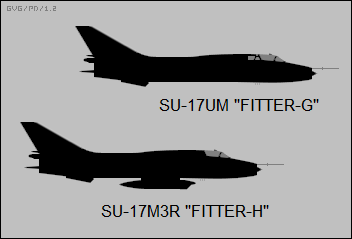
The avionics of the Su-17M3 were considerably updated to the K-23-1 nav-attack suite, with updated optical sight, radio navigation systems, flight control system, IFF -- and in particular a Klyon-PS (Maple-PS) laser rangefinder & target designator, replacing the old Fon-1400 laser rangefinder in the intake cone. The Klyon-PS was an unorthodox laser targeting system by Western standards, lacking a display / joystick system. The pilot instead simply locked onto the target using his gunsight, with the Klyon-PS automatically retaining target lock from then on. It had a field of view 12 degrees to each side, 6 degrees up, and 30 degrees down. It was said to have worked surprisingly well.
___________________________________________________________________
SUKHOI SU-17M3 "FITTER-H":
___________________________________________________________________
wingspan (swept):
10.025 meters (32 feet 11 inches)
wing area (swept):
34.5 sq_meters (371 sq_feet)
wingspan (extended):
13.68 meters (44 feet 11 inches)
wing area (extended):
38.49_meters (414 sq_feet)
length:
17.34 meters (56 feet 11 inches)
height:
5.13 meters (16 feet 10 inches)
empty weight:
10,880 kilograms (23,985 pounds)
normal loaded weight:
17,000 kilograms (37,480 pounds)
MTO weight:
19,630 kilograms (43,280 pounds)
max speed at altitude:
2,300 KPH (1,428 MPH / 1,242 KT)
service ceiling:
15,200 meters (49,870 feet)
range with warload:
2,300 kilometers (1,430 MI / 1,245 NMI)
___________________________________________________________________
The Su-17M3 also featured two six-round KDS-23 chaff-flare dispenser in the spinal hump, and was fitted with the modern SPO-15 Beryoza-L RWR. The aircraft could carry an SPS-141/142/143 radio-frequency jammer pod on an underwing pylon. A second set of belly pylons could be fitted, giving a 2 x 2 arrangement of belly pylons, but it's unusual to find pictures of machines with all four belly pylons fitted. A new "light" pylon was fitted in the middle of each fixed wing section, strictly to carry the R-60 / AA-8 Aphid AAM for self-defense.
Some of the Su-17M3s were built as "Su-17M3R" reconnaissance machines, carrying the KKR series reconnaissance pods on a centerline pylon. A number of Su-17M3s were modified to carry the Vyuga-17 conformal belly pod to support the "suppression of enemy air defenses (SEAD)" mission, using the Kh-28 (NATO AS-9 Kyle) and Kh-58 (NATO AS-11 Kilter) anti-radar missiles (ARM). These aircraft were designated "Su-17M3P".
* Su-17M3 avionics were later incorporated into Su-17UM two-seater production, resulting in the "Su-17UM3", with initial flight in 1978 and 165 built. It retained the NATO reporting name of "Fitter-G". Although the variant was clearly combat-capable, it was mainly intended to provide conversion training. Su-17UM trainers were generally brought up to Su-17UM3 standard.
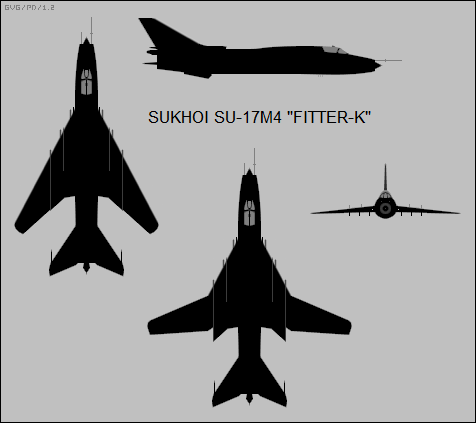
* The last production Su-17 was the "Su-17M4", which featured significantly upgraded avionics built around the PrNK-54 nav-attack suite, featuring a digital mission computer, upgraded navigation and FCS, and an improved Klyon-54 laser target designator and rangefinder. Three stock Su-17M3s were modified as development aircraft, with the first performing its initial flight on 19 June 1980. The type formally entered service in 1984, with 231 were built up to end of production of the "Fitter" family in 1990. That production quantity included some "Su-17M4R" machines for reconnaissance with the centerline KKR pod and some "Su-174MP" machines for the SEAD mission. The Su-17M4 was assigned the NATO reporting name of "Fitter-K".
Fit of the new avionics led to fit of a fixed intake cone, restricting top speed at altitude from Mach 2+ to Mach 1.7. That wasn't seen as much of a practical issue, however, since an Su-17 could only do mach 2 "clean", and it spent most of its operational time at low level anyway. The new avionics also led to the fit of a distinctive intake at the front of the tailfin leading edge. The ejection seat was upgraded to the Zvezda K-36DM.
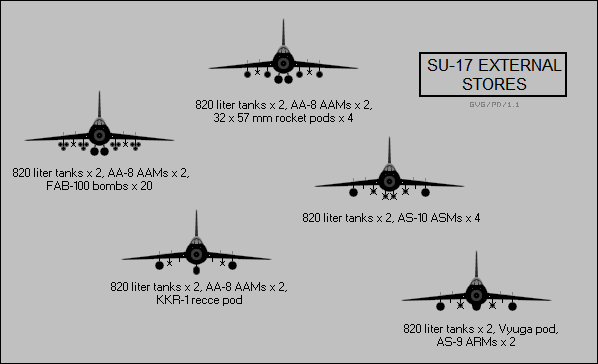
With the Su-17M4, the VVS had the ultimate "Fitter", capable of carrying a wide range of stores for conventional bombing, precision strike, SEAD, and reconnaissance. Original plans for the Su-17M4 had been far more ambitious, with the aircraft to feature a much-improved avionics suite, maneuvering flaps, and even an AL-31F afterburning bypass jet engine, as designed for the Sukhoi Su-27 "Flanker". However, VVS brass felt that about as much had been done with the Su-17 design as was practical, and settled for a more modest upgrade. Plans for a follow-on "Su-17M6" with the AL-31F engine and a fixed wing never got out of the paper stage.
BACK_TO_TOP* The swing-wing "Fitter" series machines were heavily exported in a somewhat confusing range of variants:
* At its peak, the Su-17 was the mainstay of VVS tactical strike and reconnaissance, with relatively small numbers serving with the Russian Navy air arm as well. It was the primary VVS attack type all through the 1980s war in Afghanistan, with combat duties initially performed by the Su-17, to be quickly replaced by the longer-legged Su-17M3 -- to be supplemented late in the war by the Su-17M4. Typical munitions were FAB-250 and FAB-500 general purpose bombs; 57-millimeter or 80-millimeter unguided rocket pods; or 240-millimeter unguided rockets. Due to the "hot and high" conditions often encountered in Afghanistan, bombloads were usually restricted to about 1,000 kilograms (2,200 pounds) since an aircraft had trouble getting off the runway with heavier bombloads.
Smart munitions were used sparingly, though the "Fitters" did perform aerial minelaying using the KMGU mine dispenser, which could carry up to 1,248 antipersonnel mines. "Fuel air explosive (FAE)" bombs were also used later in the conflict. The FAEs scattered a highly flammable aerosol that was then ignited, causing a spectacular fiery explosion that was extremely destructive to targets in open areas, though not very effective against dug-in targets. Cannon pods were not used much -- the Su-17's twin NR-30 cannon were perfectly effective, and the cannon pods were a maintenance headache.
In addition, Su-17M3Rs also performed reconnaissance duties, mostly at night because Afghan Mujahedin guerrillas preferred to operate under cover of darkness. Night photography using flares provided imagery that was impossible to interpret due to the rugged and broken terrain, but infrared linescan proved able to spot Mujahedin vehicles and the smoldering remains of campfires, while the ELINT system could target their communications as well. The Su-17M3Rs often carried a light munitions load, say two rocket pods, for dealing with "targets of opportunity" that might escape before a strike aircraft could arrive, and were used to drop flares to protect strike packages by distracting US-supplied heat-seeking Stinger "man-portable air defense (MANPAD)" missiles used by the Afghan Mujahedin guerrillas.
The "Fitter" proved up to the rigors of combat duty, able to soak up a remarkable amount of combat damage, though about 29 were lost in the war -- about half to accidents, half to Mujahedin anti-aircraft defenses. Aircraft in theatre were eventually fitted with more armor to protect vulnerable subsystems, and chaff-flare dispensers were scabbed on to the rear fuselage to distract Stingers. The Su-20/22 also served with Afghan government forces during the conflict, with at least three being shot down by Pakistani F-16As in aerial border clashes, and a number being destroyed on the runway by guerrilla raids. The survivors lingered on in combat during the Afghan civil war that followed the Soviet withdrawal.
In 1990, about 1,000 "Fitters" were still in service with the VVS, and the Su-17M3 saw combat in the first Chechen war of 1993:1995. However, by that time, the Su-17 force was being drawn down in the face of the post-Soviet economic collapse, and by the end of the century its numbers had greatly dwindled. It is unclear if any remain in VVS service, though it does appear that it continues to fly with various former Soviet states.
* The Su-20/22 was widely exported, with most or all Warsaw Pact nations using the type. In the mid-1990s, there were several hundred Su-20/22s in service outside of Russia, with considerable airframe life on most of the aircraft. That meant a potential market for upgrades to keep the aircraft in fighting trim, with both Israel Aircraft Industries (IAI) and the Sukhoi organization floating ideas for comprehensive updates, with the latest avionics and qualification for the latest munitions.
Nobody was all that interested in comprehensive upgrades, since the late-model "Fitters" being targeted by the programs were fairly modern and capable machines to begin with. In addition, many of the potential customers were short of cash and couldn't afford a major upgrade. However, minor upgrade programs seemed useful and practical.
Poland had acquired a fleet of 90 Su-22M4s and 20 Su-22UM3Ks from 1984. Late in the 1990s the Poles added small improvements such as Global Positioning System (GPS) receivers, new radios, and navigation aids to part of the country's fleet to improve interoperability with NATO forces. Bulgaria, which had obtained 18 Su-22M4s and 5 Su-22UMs, similarly upgraded their Su-22 machines with GPS receivers and NATO-compatible IFF at about the same time.
Bulgaria phased out their Su-22s about a decade later. Although the Poles had planned to phase out the Su-22 by the end of 2015, reality intervened, and the decision was made to keep the type in service until a replacement could be obtained. In 2014, the Poles initiated another upgrade, featuring new radios and cockpit relabeling, to keep 18 machines in service for another ten years. They were also given a new camouflage paint scheme, replacing the forest camouflage pattern with light gray undersurfaces and two-tone gray camouflage on top. The new camouflage pattern matched that of Poland's F-16s.
Users outside of the Warsaw Pact included:
The "Fitter" is in its twilight days, and will be generally out of service by mid-decade.
* The following list summaries Su-17-series variants and production, beginning with single-seaters:
That gave total production of 2,179 single-seaters, 335 two-seaters, and 2,524 Su-17s overall.
BACK_TO_TOP* One of the interesting things about the original Su-7 was its resemblance to a single-engine version of the British English Electric Lightning. Both aircraft were fast; both suffered from poor endurance and warload. The British had ideas for a next-generation Lightning with less fuel-hungry engines and outer variable-geometry wing panels. It didn't happen. The Su-17 suggests what might have been made of the Lightning had the will been there.
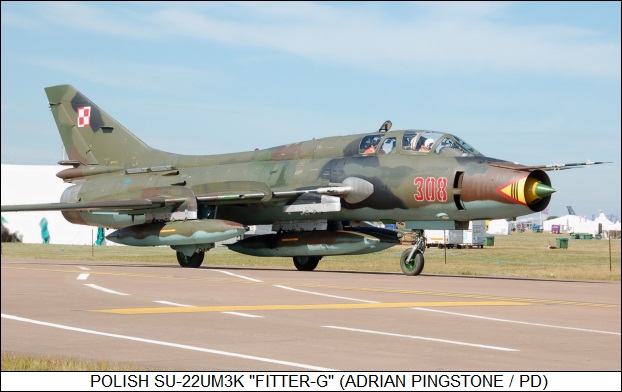
* Sources include:
* Revision history:
v1.0.0 / 01 aug 07 v1.0.1 / 01 sep 07 / Comprehensive fixes. v1.0.2 / 01 aug 09 / General cleanup. v1.0.3 / 01 jul 11 / Review & polish. v1.0.4 / 01 jun 13 / Review & polish. v1.0.5 / 01 nov 14 / Review & polish. v1.0.6 / 01 oct 16 / Review & polish. v1.0.7 / 01 sep 18 / Review & polish. v1.0.8 / 01 jul 20 / Review & polish. v1.0.9 / 01 may 22 / Review & polish. v1.1.0 / 01 apr 24 / Review & polish. (+)BACK_TO_TOP
